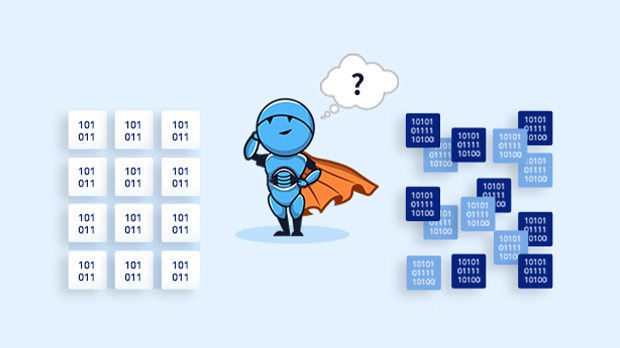Information is essential to take strategic business decisions. Often, a company’s level of success is determined by its capacity to collect relevant data, evaluate it, and act on the resulting insights. However, both the quantity and variety of data available to businesses are constantly expanding. There are several forms of business data, ranging from relational databases to your most recent tweet. This data, in all its many incarnations, may be split into two major categories: structured data and unstructured data.
According to Techjury, 95% of companies find it hard to manage their unstructured data. Structured data is simple to manage, however semi-structured and unstructured data are more difficult to arrange and extract. Data in all its forms is extremely vital to any firm and understanding how to effectively manage data helps businesses reduce mistakes and boost output. This article will examine these ideas and their distinctions in further detail.
Structured Data vs Unstructured Data: Overview
| Structured Data | Unstructured Data | |
| Definition | It can fit into any fixed field or table. | It cannot fit into any fixed field or any structure. |
| Examples | Categorized data or quantitative data | Audio files, digital behavior data, social media content, etc. |
| Users | Data Analytics or business professionals | Data engineers or data scientists |
| Storage | Data warehouse or RDBMS | Data Lakes or NoSQL database |
What is Structured Data
Data that can be meticulously organized into a predetermined structure, such as a spreadsheet with rows and columns, is structured data. The most prevalent example would be a relational database, such as those used to place retail goods orders, make hotel reservations, or establish a bank account. Typically, applications like ERP, CRM, MDM, EMI, and others utilize relational databases and structured data.
Consider the information with which we are most familiar working on a computer: customer and patient names and addresses, phone numbers, credit card numbers and expiration dates, Social Security numbers, financial transactions, and product names and SKU numbers. All of these are instances of structured data.
Structured data is easily searchable, well-organized, and quickly processed by machines. Utilizing a relational database management system or structured query language (SQL), a computer language built expressly for handling structured data, users may enter data, search across databases, alter it, and utilize it as they see fit.
Pros and Advantages of Structured Data
There are three principal advantages of organized data:
- The greatest advantage of structured data is the ease with which it can be utilized by machine learning algorithms. The specificity and organization of structured data facilitates data processing and querying.
- Simple for corporate people to use: A further advantage of structured data is that it is usable by business users with a basic comprehension of the data’s subject matter. There is no requirement for an in-depth comprehension of the various forms of data or their linkages. It provides corporate users with access to data via self-service.
- Access to a greater number of tools: Additionally, structured data has been utilized for a far longer period, as it was previously the only alternative. This indicates that there are more tried-and-true techniques for using and evaluating structured data. By utilizing structured data, data managers have additional product options.
Cons and Disadvantages of Structured Data
The primary disadvantage of structured data is its inflexibility. Here are some potential disadvantages of using structured data:
Predetermined Intent Restricts Usage
While on-write-schema data definition is a significant advantage of structured data, data with a specified structure can only be utilized for its intended purpose. This reduces its adaptability and applications.
Limited Storage Alternatives
Data warehouses often store structured data. Data warehouses are rigorous schema-based data storage solutions. Any change in requirements necessitates the update of all structured data to suit the new criteria, resulting in a tremendous waste of time and resources. A portion of the cost can be avoided by utilizing a cloud-based data warehouse, which enables higher scalability and reduces the maintenance costs associated with on-premises technology.
What is Unstructured Data
Once you understand structured data, it is straightforward to comprehend unstructured data, which is everything else. This includes voice recordings, video footage, photos, social media posts, email content, transcripts of customer care chats, machine sensor data, and a great deal more. Gartner believes that around 80% of business data is unstructured, and some estimates are much higher.
Humans and robots can produce unstructured data. Human-generated data can include audio recordings, videos such as YouTube material and surveillance footage, photographs, medical imaging, and text messages. Sensor data from turbines, aircraft engines, IoT, appliances, system logs, traffic or weather, satellite imaging, digital surveillance files, and atmospheric data are examples of machine-generated data. Unstructured data, as its name implies, lacks a specified data model, and standard data tools designed for structured data cannot process or analyze it.
Unstructured data is frequently saved in its raw form on personal flash drives, local servers, data lakes, etc., rather than in relational databases within data warehouses. To evaluate this sort of data and extract value in the form of actionable insights into every element of businesses, machines, processes, etc., sophisticated tools and solutions are required.
However, the difficulty of deriving this value is worthwhile. Big Data analytics has become such a term due to the intriguing opportunities presented by exploring enormous stockpiles of unstructured data. Using advanced data analytics and data mining, businesses may analyze their unstructured data to determine, for example, seasonal or time-of-day purchase patterns. Or study the travel patterns of traffic on the city’s roadways to determine where, when, and why bottlenecks occur. Or analyze social media posts to determine how people view a business or how they feel about a particular product. Alternatively, do predictive analytics on machine data, etc.
Insights from analytics can change the operations and services of a business. With profound data insights, businesses may gain a significant competitive advantage, find potential for new income streams, improve customer service like never before, and minimize maintenance costs and downtime, among other benefits.
Pros and Advantages of Unstructured Data
- Indefinite Use – As unstructured data does not contain any predefined rules, it can be used for more than one intended purpose.
- Flexible formatting – You can store Unstructured data in a variety of formats.
- Cheaper Storage Cost – Modern data demands with the digital revolution’s onset makes the storage for this unstructured data easier and less expensive.
- Unlimited insights – An enterprise has more unstructured data than a structured one. So, even though it is difficult to analyze Unstructured Data, this data can result in more insights that could amplify your business competitiveness.
Cons and Disadvantages of Unstructured Data
There are other disadvantages to utilizing unstructured data. It requires specialist knowledge and equipment to be utilized to its best capacity.
- Data science skills are necessary to prepare and interpret unstructured data, which is the major disadvantage of unstructured data. A typical business user cannot utilize unstructured data as-is owing to its lack of definition and format. Utilizing unstructured data involves not just knowledge of the data’s topic or domain, but also knowledge of how the data may be connected to be valuable.
- specialized equipment: In addition to experience, manipulating unstructured data requires specific tools. Standards are designed for usage with structured data, leaving a data manager with few options for unstructured data products, some of which are in their infancy.
Five key Differences Between Structured Data and Unstructured Data
Defined vs Undefined Data
Structured data are sorts of data that are precisely specified and organized. Unstructured data is often saved in its natural format, but structured data resides in rows and columns and can be mapped into pre-defined fields.
Unstructured data, unlike structured data, which is ordered and easy to retrieve in relational databases, has a predetermined data model and is thus undefined.
Qualitative vs Quantitative Data
Typically, structured data is quantitative data, meaning that it consists of numbers or items that can be tallied. Regression (to predict associations between variables), classification (to estimate likelihood), and data clustering are methods for data analysis (based on different attributes).
Unstructured data, on the other hand, is typically classified as qualitative data and cannot be processed and evaluated with normal tools and techniques. Examples of qualitative data sources in a corporate environment include consumer surveys, interviews, and social media interactions. To extract insights from qualitative data, complex analytics approaches such as data mining and data stacking are required.
Storage in Data Lakes vs Data Warehouses
Unstructured data is often kept in data lakes, whereas structured data is typically saved in data warehouses. The destination of the data’s trip via an ETL pipeline is a data warehouse. In contrast, a data lake is a repository where data is preserved in its original format or after completing a rudimentary “cleaning” procedure.
Both have the potential for application in the cloud. Structured data takes up less storage space, but unstructured data demands more. For instance, even a little image occupies more space than several pages of text.
As with databases, organized data is often kept in a relational database management system (RDBMS), whereas unstructured data is best suited for non-relational, or NoSQL, databases.
Learn more about: Data lakes vs Data warehouses.
Ease of Evaluation
The ease of analysis is one of the most fundamental distinctions between organized and unstructured data. Searching structured data is simple for both people and algorithms. Unstructured data, on the other hand, is inherently more difficult to find and must be processed to be comprehensible. It is difficult to deconstruct because it lacks an established data model and is thus incompatible with relational databases.
While there is a large variety of sophisticated analytics tools for structured data, most analytical tools for mining and organizing unstructured data, such as NLP and ML, are still under development. The absence of a specified framework makes data mining difficult, and it is difficult to build best practices for handling data sources such as rich media, blogs, social media data, and consumer interactions.
Defined Format vs Multiple Formats
Text and numeric values are the most typical formats for organized data. A data model defines beforehand the structure of data.
Unstructured data, on the other hand, can take on many different forms. It may include audio, video, and pictures, as well as email and sensor data. The unstructured data lacks a data model and is stored directly or in a data lake that does not require transformation.
What is Semi-structured Data
A third type, semi-structured data, comes in between the first two. It is a type of structured data that does not conform to the formal database structure. Even if it does not perfectly meet the definition of structured data, it includes tagging systems or other markers to separate various pieces and enable search. Smartphone photographs are a common instance of semi-structured data. Every photograph shot with a smartphone contains both unstructured visual content and recognizable (and structured) information, such as time and location tags. JSON and XML are common forms of semi-structured data, and these are utilized by website developers to assist Google comprehend more about the page’s content.
How Do Unstructured and Structured Data Affect Businesses
In the end, businesses utilize data analysis tools to make better educated decisions across all company units. Adopting a data-driven culture provides businesses with a significant competitive advantage by enabling business leaders to quickly identify and capitalize on business opportunities, provide superior customer service, design more effective sales and marketing campaigns, and develop more compelling products and services for their customers.
Structured data provides just a fraction of information about a company’s clients and their behaviors, even though many organizations have typically utilized structured data using Excel modeling. Now, organizations can utilize BI solutions such as Qlik, Microsoft Power BI, and Tableau to analyze both structured and unstructured data simultaneously and get even more valuable insights in record time.
Analysts may still be required to standardize certain unstructured data, but technologies such as natural language processing (NLP) are progressively transforming unstructured data into a format that BI systems can read and analyze. BI systems then employ AI and ML to identify trends and eliminate unnecessary or noisy data. Using BI tools and embedded analytics, analysts and business executives may query this extended database and view the data in a new way. Using AI and ML, organizations can generate new questions and actionable insights from a larger, more comprehensive data collection. Rather than relying exclusively on historical data to anticipate the future, BI tools employ AI to provide predictive analytics to firms, which may assist them in making more profitable business decisions and introduce new revenue-generating prospects.
Before, many businesses could only utilize data that was easily available in a spreadsheet, which may take an analyst days or weeks to present in a report. To prepare for the following quarter or make a crucial decision, company executives would have to spend numerous days combing over diverse information. Now that structured and unstructured data can be easily examined and accessible through self-service BI technologies, decision makers throughout the organization can leverage analytics to spend less time discussing and more time taking value-driven action.
Conclusion
We have spoken at length about the use of big data in a variety of industries. The market for big data analytics is projected to reach $103 billion by 2023, as the number of big data we gather continues to increase. In accordance with this, it is anticipated that 2.72 million new employments would be produced in the field of data science in the coming years. Soon, data storage will no longer be a problem, as cloud-based storage is expected to disrupt the way organized and unstructured data are now stored. This will offer extra chances for data scientists to maximize the possible insights from the data they are gathering by developing new algorithms with the capacity to utilize the data in novel ways.
Whether data is organized or unstructured, firms that can effectively gather and analyze data from the most relevant sources will gain a substantial competitive edge. According to the adage “Data is the new oil,” organizations who can extract consumer behavior insights and align their goods and services accordingly will develop far more swiftly than those that rely on more conventional engagement approaches.













